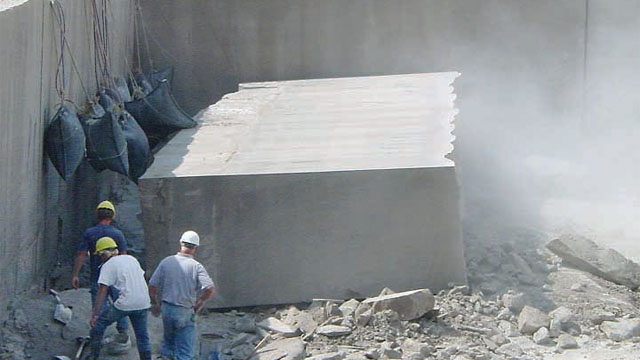April 6, 2011 7:30 AM CDT
Indiana limestone provides innovative design solutions for architects and designers, and has a long kinship as the mason’s friend, since it’s a durable, natural stone that’s readily available and easy to work in the field. As a natural stone, Indiana limestone provides beauty, durability, versatility, and ease-of-maintenance to every project, big or small. Technological advances in both quarrying and fabrication have made the material more affordable than ever.
While early pioneer settlers used some Indiana limestone for foundations, door sills and memorial markers, the earliest quarry on record opened in 1827. Railroads came through the area in mid-19th century, expanding the market and increasing demand. After extensive fires in Chicago and Boston, Indiana limestone showed its durability, which again increased demand. By 1929, at the height of architecture utilizing American natural stone, Indiana limestone accounted for 12 million cubic feet of dimension stone used.
Indiana limestone is classified by the Indiana Limestone Institute into two colors and four grades. Colors are buff and gray, though color options are available in more subtle variations to match most every project need.
For instance, Indiana Limestone Co., through its different quarries, also offers Full Color Blend, a natural compilation of the full range of buff to light gray shades with subtle veining; Silver Buff, a buff color with subtle silver colored veining in the foreground; and Variegated, an unselected mixture of buff and gray tones with a wide range of grain structure and veining (it’s also a grade).
Grade classifications for Indiana limestone are based on the degree of fineness of the grain particles and other natural characteristics that make up the stone. The structural soundness of each grade of Indiana limestone is, essentially, identical.

Low Lifecycle costs. Indiana limestone is virtually maintenance free. It requires only occasional re-pointing of stone joints and cleaning, if desired. With minimal care, Indiana limestone projects will serve present and future generations for many years to come.
Reusable/recyclable. It is common in restoration projects involving Indiana limestone that the majority of the original stone remains in place for continued use, once the restoration work is completed. Indiana limestone also can be taken from one project and re-used as elements in another building, for landscape stones, perimeter walls, or even as site fill. It’s completely inert; Indiana limestone came from nature and can go back to same.
Environmentally friendly production processes. Since the first organized Indiana limestone quarry opened in 1827, Indiana limestone has been in constant use, making an impact on American architecture. Projects utilizing Indiana limestone, many of which are up to 100 years old, exist in every American city, in many small towns and villages, in Canada, and in every type of atmosphere. Though found in only three Indiana counties, it is estimated that with current production methods, a 500- to 1000-year supply of stone remains.
Leadership in Energy and Environmental Design (LEED) credits available for use of Indiana Limestone:
Indiana Limestone: A Natural Wonder
The role of limestone in American architecture

Once Limestone block is sawn, compressed air bags inflate to force the 12-ton block onto its side in preparation for extraction from this Indiana Limestone Co. quarry.
What do some of the most prestigious works of American architecture, namely the Empire State Building, the Pentagon, and the Washington National Cathedral have in common? They all were built with natural Indiana limestone from Indiana Limestone Co., as were 35 of 50 state capitol buildings. With more than a century of monumental projects to showcase the beauty and durability of this natural stone, Indiana limestone continues to be used and desired in today’s architecture. Indiana limestone can be found on all sizes and types of buildings, from convention centers to college campuses, from New York City high rises to local high schools, and from residences to monuments across the country.Indiana limestone provides innovative design solutions for architects and designers, and has a long kinship as the mason’s friend, since it’s a durable, natural stone that’s readily available and easy to work in the field. As a natural stone, Indiana limestone provides beauty, durability, versatility, and ease-of-maintenance to every project, big or small. Technological advances in both quarrying and fabrication have made the material more affordable than ever.
300 Million Years in the Making
From where did this fine natural stone come? A shallow inland sea covered most of the Midwest during the Mississippian age, more than 300 million years ago. Indiana limestone is primarily formed of the calcium carbonate that was deposited over millions of years as marine fossils decomposed at the bottom of this sea. These deposits are part of the geological formation known as Salem limestone, an outcropping that trends in a belt with a width ranging from one to nearly 10 miles wide, and winding through three counties in south central Indiana. Indiana limestone is quarried from this belt.While early pioneer settlers used some Indiana limestone for foundations, door sills and memorial markers, the earliest quarry on record opened in 1827. Railroads came through the area in mid-19th century, expanding the market and increasing demand. After extensive fires in Chicago and Boston, Indiana limestone showed its durability, which again increased demand. By 1929, at the height of architecture utilizing American natural stone, Indiana limestone accounted for 12 million cubic feet of dimension stone used.
How it Stacks Up
Indiana limestone is a freestone, and it is a grainstone of uniform texture and grade that has gained recognition throughout the world as a premier dimension stone. Indiana limestone exhibits no preferential direction of splitting. Therefore, it can be cut or carved in almost limitless ways and in a variety of shapes and sizes. This property allows the stone to be sawn, planed, turned on a lathe, hand cut, or hand carved, so that it meets the requirements from the most basic of jobs or the most demanding of architectural designs.Indiana limestone is classified by the Indiana Limestone Institute into two colors and four grades. Colors are buff and gray, though color options are available in more subtle variations to match most every project need.
For instance, Indiana Limestone Co., through its different quarries, also offers Full Color Blend, a natural compilation of the full range of buff to light gray shades with subtle veining; Silver Buff, a buff color with subtle silver colored veining in the foreground; and Variegated, an unselected mixture of buff and gray tones with a wide range of grain structure and veining (it’s also a grade).
Grade classifications for Indiana limestone are based on the degree of fineness of the grain particles and other natural characteristics that make up the stone. The structural soundness of each grade of Indiana limestone is, essentially, identical.
- Select – Fine-grained stone, having a controlled minimum of inclusions and veining
- Standard – Average- to large-grained stone, permitting an average amount of inclusions and veining
- Rustic – Large- to coarse-grained stone, permitting an above-average amount of inclusions and veining
- Variegated – An unselected mixture of the other three grades, permitting both the buff and gray colors.

Washington National Cathedral in Washington, D.C., showcases the durability and consistency of Indiana limestone.
Sustainability
Indiana limestone is a 350 million-year-old representation of life naturally fused to form a unique building material. Because it is extracted with relative ease, Indiana limestone is an outcrop formation that adds little to the already low energy inputs of its workability. Cladding countless monumental buildings, Indiana limestone has shown that it withstands the tests of time, and when decommissioned, can be reused or returned harmlessly to the earth.- Naturally formed
- Inert – no VOC emissions or pollutants
- Low energy inputs
- Durable – lifespan greater than 100 years
- Eligible for LEED credits
Low Lifecycle costs. Indiana limestone is virtually maintenance free. It requires only occasional re-pointing of stone joints and cleaning, if desired. With minimal care, Indiana limestone projects will serve present and future generations for many years to come.
Reusable/recyclable. It is common in restoration projects involving Indiana limestone that the majority of the original stone remains in place for continued use, once the restoration work is completed. Indiana limestone also can be taken from one project and re-used as elements in another building, for landscape stones, perimeter walls, or even as site fill. It’s completely inert; Indiana limestone came from nature and can go back to same.
Environmentally friendly production processes. Since the first organized Indiana limestone quarry opened in 1827, Indiana limestone has been in constant use, making an impact on American architecture. Projects utilizing Indiana limestone, many of which are up to 100 years old, exist in every American city, in many small towns and villages, in Canada, and in every type of atmosphere. Though found in only three Indiana counties, it is estimated that with current production methods, a 500- to 1000-year supply of stone remains.
Leadership in Energy and Environmental Design (LEED) credits available for use of Indiana Limestone:
- SS Credit 7.1: Heat Island Effect, Non-Roof
- EA Credit 1: Optimize Energy Performance
- MR Credits 1.1, 1.2: Building Reuse, Maintain 75 percent to 95 percent of Existing Walls, Floors, and Roof
- MR Credits 2.1, 2.2: Construction Waste Management, Divert 50 percent to 75 percent from Disposal
- MR Credits 3.1, 3.2: Materials Reuse, 5 percent to 10 percent
- MR Credits 5.1, 5.2: Regional Materials
- ID Credit 1: Innovative Design
- LEED Canada Credit 8: Durable Building
About the Author
Jennifer Morrell was the editor of Masonry magazine. She has 20 years of experience in the publishing industry as a writer and editor, covering such topics as real estate and construction, insurance, health care, relationships and sports. A graduate of The University of Georgia’s Grady College of Journalism, she earned a Bachelor of Arts degree in magazines and is an award-winning newspaper columnist.
Sources: Indiana Geological Survey, Indiana Limestone Institute of America, Indiana Limestone Company
Photo ©2010 Indiana Limestone Company/MyersCroxton Group.


















